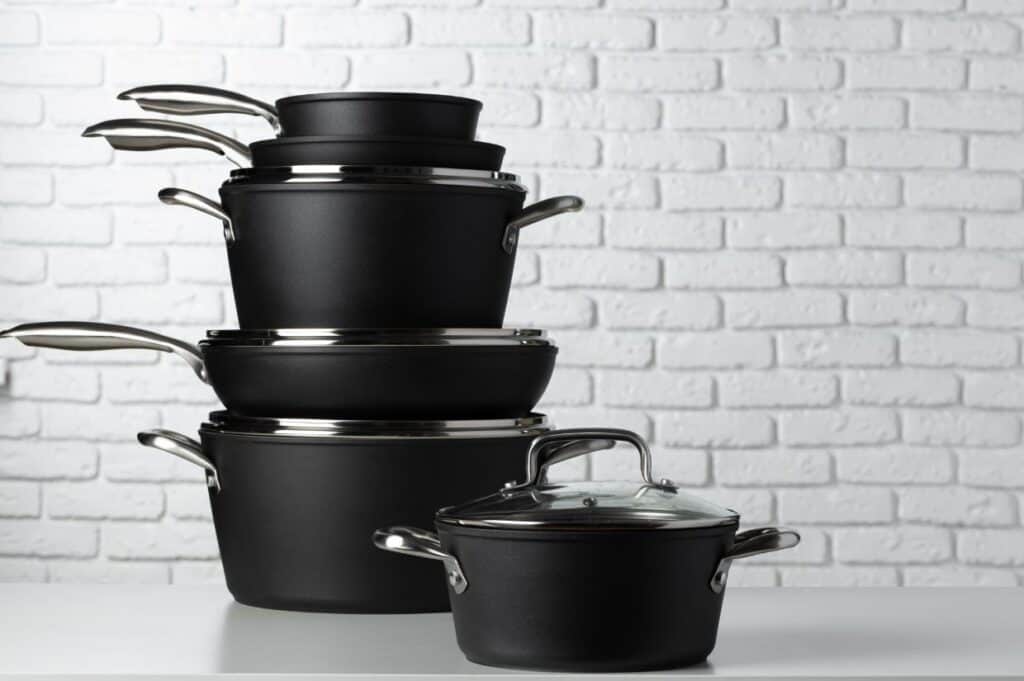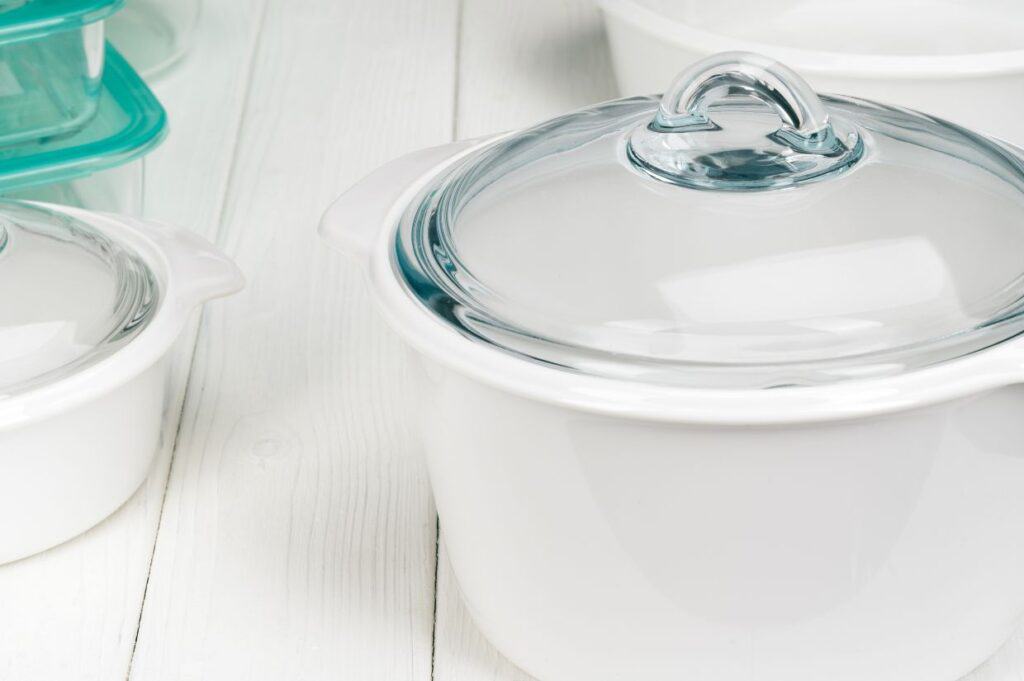We go to extreme lengths to make sure our food is safe, but are you taking the same precautions when it comes to your cookware? Choosing the best non-toxic cookware considers quality, price, functionality and safety.

This post may contain affiliate link(s). As an Amazon Associate, I earn from qualifying purchases. See Disclosures.
What does non-toxic cookware mean?
Non-toxic cookware doesn’t contain harmful chemicals that separate and mix into food while cooking or release toxic substances into the air when overheated. Generally, non-toxic items, like cast iron cookware, are made without non-stick coatings. Non-stick cookware may contain potentially harmful substances like:
- Per- and polyfluorinated substances or PFAS: These are substances that resist oil, stains, grease and heat. Studies by the Agency for Toxic Substances and Disease Registry show that PFAS may negatively affect the thyroid, liver and immune system.
- Polytetrafluoroethylene or PTFE: This is a fluoropolymer commonly known as Teflon, best known for its non-stick properties. As per studies done in StatPearl Journal, cookware coated in PTFE may release toxic fumes when overheated.
- Perfluorooctanoic Acid or PFOA: PFOA is a type of PFAS used in some non-stick cookware. The toxic effects of PFOA on humans are still unclear, but according to the Centers for Disease Control and Prevention, animal studies reveal its detrimental effect on the liver.
These substances are called forever chemicals because they can remain in the body for years, if not decades, and take a very long time to degrade. These chemicals can also contaminate the air, water and soil.

What to look for in non-toxic cookware
Some cookware brands claim their products are non-toxic, but this is not always true. Here are some of the most important factors to consider when buying truly non-toxic cookware:
Non-toxic materials
Opt for cookware without non-stick coatings, such as stainless steel, cast iron or carbon steel. Ceramic cookware is also a great option if you still want non-stick pots or pans, but they are not as durable and generally need more care.
“I switched to non-toxic cookware to prioritize my family’s health. My go-to pieces are definitely stainless steel and cast iron — they’re reliable and safe, but I also use a non-toxic, non-stick frypan for things like eggs.”
— Lisa Wells, Cook Eat Well
Reputable brands
In 2002, the Environmental Protection Agency banned the production of PFOA non-stick coatings, requiring all cookware made in the USA to be free of PFOA. The EPA also banned PFOA in Teflon in 2015.
You can’t be sure if cookware made outside of the US follows the same PFAS rules, so be wary of buying knock-offs or suspiciously cheap products. Instead, choose brands with a good track record and comply with food contact material regulations set by the Food and Drug Administration.
Clear care instructions
Choose a product that has straightforward usage and care instructions. While non-toxic cookware may not leach chemicals into your food, incorrect use may harm your cookware or stovetop. For example, overheating a stainless steel pan can cause it to burn or warp.

Best brands that sell non-toxic cookware
With thousands of non-toxic cookware options on the market, how do you know which ones are worth your money? Don’t worry, I’ve narrowed down the top five brands for you to consider:
SENSARTE
SENSARTE has my heart when it comes to aesthetically pleasing cookware. Their ceramic cookware is made from natural ceramic, free from PFOA, PTFE, PFAS, lead and cadmium, but it is still superiorly non-stick.
If I had to pick a favorite, it would be their 8-inch ceramic skillet. It has a good weight to it, a nice wooden stay-cool handle and an easy-to-clean surface. Plus, it’s one of my favorite green products, as SENSARTE makes its pans from recycled aluminum.
I highly recommend this pan for everyday cooking because of its convenient size and non-stick properties. However, I would avoid using it for cooking temperatures beyond medium heat to maintain its durability.
Greenlife
If you’re looking for a two-in-one deal for non-toxic cookware, check out Greenlife’s ceramic sauce pot set with one-quart and two-quart pots. Aside from their beautiful turquoise color, my favorite thing about these pots is that they’re dishwasher safe — perfect for people like me who prioritize convenience.
Another pro of these sauce pots is their soft grips that keep your handles cool while reducing the strain on your hands and wrists while cooking. They are also shockingly easy to clean, even with stuck-on food bits.
Like any ceramic pot or pan, use rubber or wooden cooking tools to prevent surface scraping. Other than that, using this sauce pot duo is a breeze.
Lodge
I wanted the perfect cast iron skillet to reverse sear my pork chops. Cast iron is excellent at retaining heat and cooking meat evenly, making it my go-to tool for cooking meat recipes.
A lot of cast iron options came along my way, but nothing beat Lodge’s cast iron skillet. It has zero synthetic coatings or chemicals, just high-quality cast iron you can easily season, clean and rub with oil.
A new pan has a thick silicone handle holder to keep your hands safe. Unfortunately, I lost the holder a few years ago, but the pan still looks as good as new at 5 years old — something to consider if you’re looking for durability. All you need to know is how to season a cast iron skillet, and you’ll get the most out of this pan.
Cuisinart
Stainless steel produces no toxins that can get into your food and doesn’t react with ingredients. However, not all stainless steel cookware is equal, and you certainly don’t want janky pots or pans that wouldn’t last a year.
That’s why I invested in the 11-piece cookware set from Cuisinart, and I can tell you it was one of my best decisions. It has everything you need, including three saucepans with glass covers, two skillets, a stockpot with a glass cover and a steamer insert.
All of them are easy to clean as long as you don’t burn your food, and I love how they have lips around the edge that help me pour mess-free. Just make sure to use pot holders when taking off the glass covers, as the handles can get pretty hot.
Crock-Pot
The Crock-Pot brand takes slow cooking to the next level. Their enameled cast iron Dutch oven is my go-to cookware if I want an easy one-pot meal and have an easy clean-up afterward.
These pots come in three sizes, but I recommend the 5-quart option for family-size stews and slow-cooked meals. I have the gray one, but I love that Crock-Pot offers a wide range of colors.
Additionally, this Dutch oven has a self-basting lid, so you won’t have to check your food repeatedly. Plus, the enamel coating ensures nothing sticks to it, making handwashing easy. The only downside? You can’t put it in your dishwasher.
Final thoughts
After reading about potential toxins, you may be more suspicious about your cookware — and that’s good. Harmful chemicals might be present in things we least expect, and it pays to know how to avoid them.
If you’re using non-stick cookware, that doesn’t automatically mean they have toxic compounds. However, it’s better to err on the side of caution and replace them with non-toxic cookware from the most reputable brands.
Jessica Haggard is dedicated to helping people cook easy everyday recipes focusing on bioavailable and nutrient-dense foods. She helps people overcome food allergies and discover healthy recipes that make a difference in their health with gluten-free, low-carb and keto cooking at Primal Edge Health.